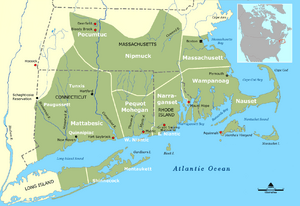Patuxet facts for kids
Quick facts for kids
Patuxet Village
|
|
|---|---|

Historic area of the Patuxet tribe
|
|
| Country | United States |
| State | Massachusetts |
| County | Plymouth |
| Settled | Unknown |
| Defunct | ~1617 |
| Elevation | 187 ft (57 m) |
| Population | 0 |
The Patuxet were a group of Native Americans. They were part of the larger Wampanoag tribal family. The Patuxet lived in what is now Plymouth, Massachusetts. They were among the first Native Americans to meet European settlers in the early 1600s. Sadly, most of the Patuxet people died from serious diseases. The last known Patuxet was a man named Tisquantum. He played a very important role in helping the Pilgrim settlers survive. Tisquantum died in 1622.
Contents
What Happened to the Patuxet?
The Patuxet people faced a terrible time. Many died from a series of sicknesses in the early 1600s. These diseases spread across southeastern New England. They were especially harmful to the Wampanoag and nearby Massachusett tribes. In some villages, almost everyone died.
When the Pilgrims arrived in 1620, nearly all the Patuxet were gone. Only Tisquantum was left. Historians believe these diseases might have been smallpox or other serious illnesses.
The Story of Squanto
Some European ship captains would capture Native Americans. They would then sell them as slaves. This happened to a Patuxet man named Tisquantum in 1614. A captain named Thomas Hunt kidnapped him. Tisquantum was taken to Spain to be sold.
After some time, Tisquantum gained his freedom. He managed to travel to England. He lived there for several years and worked with a shipbuilder. Later, he became an interpreter for a British trip to Newfoundland. From there, Tisquantum finally returned home.
But when he arrived, he found a sad truth. Diseases had killed everyone in his village. Tisquantum was the only Patuxet left. He later died in November 1622 from a sickness.
The Pilgrims and Patuxet Land
The first English settlers of Plymouth Colony chose a special place for their new home. It was the site of a former Patuxet village. This land had already been cleared and farmed by the Patuxet people. This made it a good spot for the Pilgrims to settle.
Tisquantum was incredibly important to the survival of the English settlers. A Native American leader named Samoset first met the Pilgrims. He then introduced them to Tisquantum. Tisquantum spoke English well. He had settled at the site of Squanto's old village.
From that moment, Squanto dedicated himself to helping the Pilgrims. He taught them many vital skills. He showed them how to grow important crops like beans, corn, and squash. These crops were known as the "Three Sisters."
Squanto also helped the Pilgrims make friends with Massasoit. Massasoit was the great leader of the Wampanoag people. Squanto helped them sign a peace treaty. This treaty allowed the settlers to live in the area. Massasoit kept this treaty until he died in 1661.
The First Thanksgiving
In the fall of 1621, something special happened. The Plymouth colonists and the Wampanoag shared a harvest feast. This celebration lasted for three days. About 90 Wampanoag people joined the entire Pilgrim village.
This event is seen as a symbol of friendship. It showed how English colonists and Native Americans could work together. This feast later inspired the national holiday of Thanksgiving in the United States. The celebration took place on the historic land of the Patuxet villages. Squanto's help in making the peace treaty led to this joint feast. It was a celebration of the colonists' first successful harvest.


